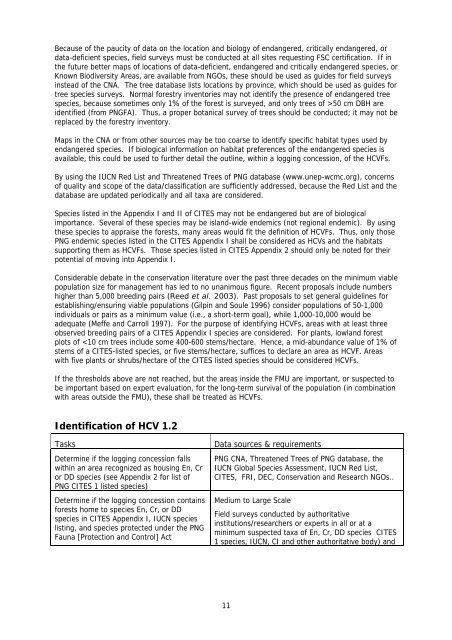A National Interpretation of the High Conservation Value Forest ...
A National Interpretation of the High Conservation Value Forest ...
A National Interpretation of the High Conservation Value Forest ...
Create successful ePaper yourself
Turn your PDF publications into a flip-book with our unique Google optimized e-Paper software.
Because <strong>of</strong> <strong>the</strong> paucity <strong>of</strong> data on <strong>the</strong> location and biology <strong>of</strong> endangered, critically endangered, or<br />
data-deficient species, field surveys must be conducted at all sites requesting FSC certification. If in<br />
<strong>the</strong> future better maps <strong>of</strong> locations <strong>of</strong> data-deficient, endangered and critically endangered species, or<br />
Known Biodiversity Areas, are available from NGOs, <strong>the</strong>se should be used as guides for field surveys<br />
instead <strong>of</strong> <strong>the</strong> CNA. The tree database lists locations by province, which should be used as guides for<br />
tree species surveys. Normal forestry inventories may not identify <strong>the</strong> presence <strong>of</strong> endangered tree<br />
species, because sometimes only 1% <strong>of</strong> <strong>the</strong> forest is surveyed, and only trees <strong>of</strong> >50 cm DBH are<br />
identified (from PNGFA). Thus, a proper botanical survey <strong>of</strong> trees should be conducted; it may not be<br />
replaced by <strong>the</strong> forestry inventory.<br />
Maps in <strong>the</strong> CNA or from o<strong>the</strong>r sources may be too coarse to identify specific habitat types used by<br />
endangered species. If biological information on habitat preferences <strong>of</strong> <strong>the</strong> endangered species is<br />
available, this could be used to fur<strong>the</strong>r detail <strong>the</strong> outline, within a logging concession, <strong>of</strong> <strong>the</strong> HCVFs.<br />
By using <strong>the</strong> IUCN Red List and Threatened Trees <strong>of</strong> PNG database (www.unep-wcmc.org), concerns<br />
<strong>of</strong> quality and scope <strong>of</strong> <strong>the</strong> data/classification are sufficiently addressed, because <strong>the</strong> Red List and <strong>the</strong><br />
database are updated periodically and all taxa are considered.<br />
Species listed in <strong>the</strong> Appendix I and II <strong>of</strong> CITES may not be endangered but are <strong>of</strong> biological<br />
importance. Several <strong>of</strong> <strong>the</strong>se species may be island-wide endemics (not regional endemic). By using<br />
<strong>the</strong>se species to appraise <strong>the</strong> forests, many areas would fit <strong>the</strong> definition <strong>of</strong> HCVFs. Thus, only those<br />
PNG endemic species listed in <strong>the</strong> CITES Appendix I shall be considered as HCVs and <strong>the</strong> habitats<br />
supporting <strong>the</strong>m as HCVFs. Those species listed in CITES Appendix 2 should only be noted for <strong>the</strong>ir<br />
potential <strong>of</strong> moving into Appendix I.<br />
Considerable debate in <strong>the</strong> conservation literature over <strong>the</strong> past three decades on <strong>the</strong> minimum viable<br />
population size for management has led to no unanimous figure. Recent proposals include numbers<br />
higher than 5,000 breeding pairs (Reed et al. 2003). Past proposals to set general guidelines for<br />
establishing/ensuring viable populations (Gilpin and Soule 1996) consider populations <strong>of</strong> 50-1,000<br />
individuals or pairs as a minimum value (i.e., a short-term goal), while 1,000-10,000 would be<br />
adequate (Meffe and Carroll 1997). For <strong>the</strong> purpose <strong>of</strong> identifying HCVFs, areas with at least three<br />
observed breeding pairs <strong>of</strong> a CITES Appendix I species are considered. For plants, lowland forest<br />
plots <strong>of</strong>

















